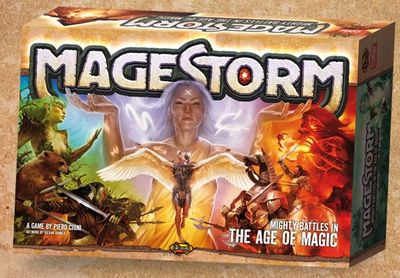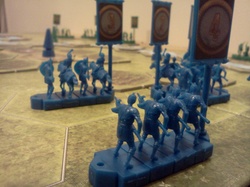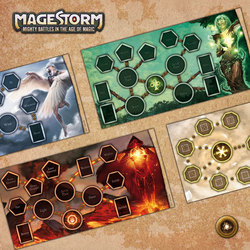 Review: Magestorm - It's Raining Mediocrity
Review: Magestorm - It's Raining Mediocrity

Magestorm is a 2010 European release by Nexus Games (NG) International and was designed by Piero Cioni. Earlier this year, the game saw a North American release and Nexus Games was kind enough to send a review copy to us here at Critical Gamers, to which we would like to thank them. Magestorm is a 2 player head-to-head fantasy wargame that marries the excitement of spell casting with the strategy of army unit coordination. Magestorm is meant for players aged 12 and up and takes about 60-90 minutes to setup and play.
The Game
Magestorm takes place in the fantasy world of Aleen where the armies of the Kragis and Láusjan fight for land and survival. The Kragis have landed on the shores of Tys and continue to expand and consume the resources of the lands that the Láusjan have lived in harmony with and guarded. The Láusjan existence and way of life are being threatened and the only option for them is to fight back.
Now I don't know about you, but this whole premise sounds suspiciously similar to the early history of the Americas with the arrival of the settlers to the new land and their eventual colonization and expansion against the Native American people. Whether this is intentional I cannot say, but it does bear a striking resemblance.
Apparently there are also mages involved in the story as well, but they just seem thrown in. From what I have read in the booklet there is no indication of where these mages come from or who they are, just that both sides have them and they are more powerful than armies. It is through the combined might of the mages and the troops that the Kragis and the Láusjan battle for control of the lands and fight for their existence.

Game Pieces
Out of all the parts of Magestorm, I feel that this is where the game shines the most. The game pieces are well done. The artwork is very colorful and vibrant and is apparent even from the box cover, and the quality of the tokens and terrain tiles are excellent. While I wouldn't say they are the best I have ever seen, I would say that Nexus Games has produced a quality as high as some of the bigger named publishers like Fantasy Flight Games and Z-Man Games.
The Rules Booklet is laid out very nicely with plenty of examples (almost one on each page), a glossary, and a table of contents on the back page. However, it is 39 pages long, which I find to be a little lengthy, but I can understand the length due to the somewhat complex rules and tons of examples. The game also comes with a Scenario Booklet which includes 10 different scenarios that include terrain setup, army composition, and starting rules. As with the Rules Booklet, the Scenario Booklet is well laid out and easy to read, which I am all for.
One area that I would like to mention are the miniatures and their assembly. They use an interesting "rail" system where four individual miniature pieces are snapped onto a railing base. I like this system as it allows the player to mix and match their unit types on the railing for some variety. There is a rule that states that unique troop miniatures must be used if a unit of troops has at least one of those troop types. For example, the Kragis have a mounted unit called the Waldwika; if a Waldwika is present in a unit, then a miniature that represents a mounted unit must be placed on the base. The Waldwika is the only unit in the game (currently) that is considered a unique unit making this rule valid for only one troop type. Unless the expansions includes additional unique troops, this feels like a useless rule, which alludes to the entire point of the railing base style of miniatures. I would rather not have to construct every unit of troops if there is no functional purpose for it.
The game also includes reference sheets for both the mage and the race types. These are a big help when playing and I highly suggest using them.

Game Play
Magestorm is a wargame at its core with the main focus of the game play on unit/troop movement and combat with a mage and spell casting aspect thrown in for some spice. It uses a conventional hexagon terrain system with individual terrain tiles with the layout determined by the scenarios. The base game comes with 10 different scenarios utilizing different types of victory conditions that includes most troops eliminated after X rounds, capture and hold, and victory point based matches, among others.
One thing that Magestorm does differently than a lot of other wargames is their movement. The difference is the objective markers and the strategic points. The way this works is that each player is allotted a scenario determined amount of strategic points that the players spend to perform strategic-type spells, change the placement of their objective markers, or put hold markers on units. The location of the objective markers are what determines where the units move (assuming they do not have a hold marker) as they are required to head in the direction of the closest marker and at the shortest distance. There are some edge cases dealing with markers at equal distance or objects blocking paths and are discussed in the rules. What I find interesting about the movement system is that the player is telegraphing their troop movement to the other player and only has limited amount of strategic points to make changes to the objective markers. I am not sure that I like this movement mechanic as it really limits the players control over their units and can ruin complex strategies if careful planning isn't performed. It does make the player choose between casting spells or changing troop movement, but when given the choice to do free damage against the opponent or alter a unit's path, nearly every time the spell took priority.
Editor's Note - The statement "It does make the player choose between casting spells or changing troop movement, but when given the choice to do free damage against the opponent or alter a unit's path, nearly every time the spell took priority." is incorrect. The player does not need to spend strategic points in order to cast strategic spells. The limitation is based off the number of times the spell is allowed per Strategic Phase and the number of spell points currently available in that spell.
Then there are the mages. Three of the mages including the Airmage, Druid, and Firemage are all very similar to each other, containing stat boosters, one strategic damage spell, and summons. The fourth mage called the Fate Guardian is the most interesting as they can predetermine dice rolls and force rerolls. I have not been able to play the Fate Guardian yet, but my opponents who have have not liked it. I personally would like to see how effective it could be if it is played correctly as from a first glance it seems a bit overpowered. Because mages make or break the game, having an overpowered type of mage could ruin the experience for players.
Final Thoughts
Please keep in mind that I have only played this title a few times and have not had the opportunity to experience all of the scenarios and mages, but from my experiences I have to say that I wasn't very impressed, nor was I totally disappointed. This is where the title of my review comes into play. Magestorm came across as a title that does enough right to make it playable but doesn't do anything special enough to make it memorable. Each time I have left the game feeling like there wasn't much meat on the bones and lacking the desire to play another round. I think with a little bit of tweaking by Nexus Games through expansions, this game could have enough substance to push it past palatable and into the tasty range for me. I almost feel like the issue is that the game is a 2 player game when it should be 2-4. My suggestion to Nexus Games would be to add, in the next expansion, more races, terrain, a larger board, and scenarios that increases the player total. I give Magestorm a 2.5 out of 5.
Read More in: Board Games | Our Game Reviews
Share this Article with others: 
Related Articles:
Came straight to this page? Visit Critical Gamers for all the latest news.
Posted by Critical Gamers Staff at May 23, 2011 9:34 PM
